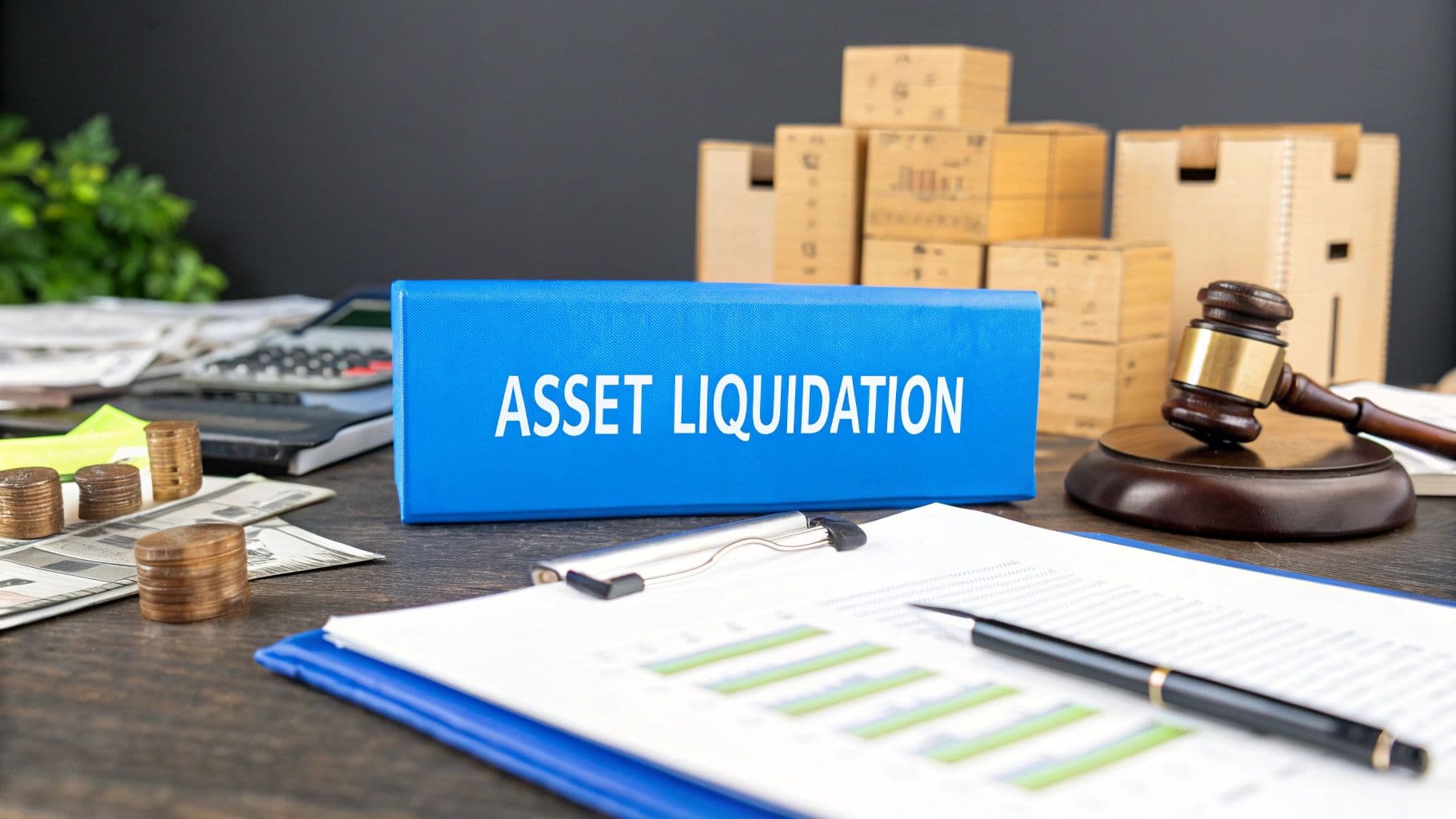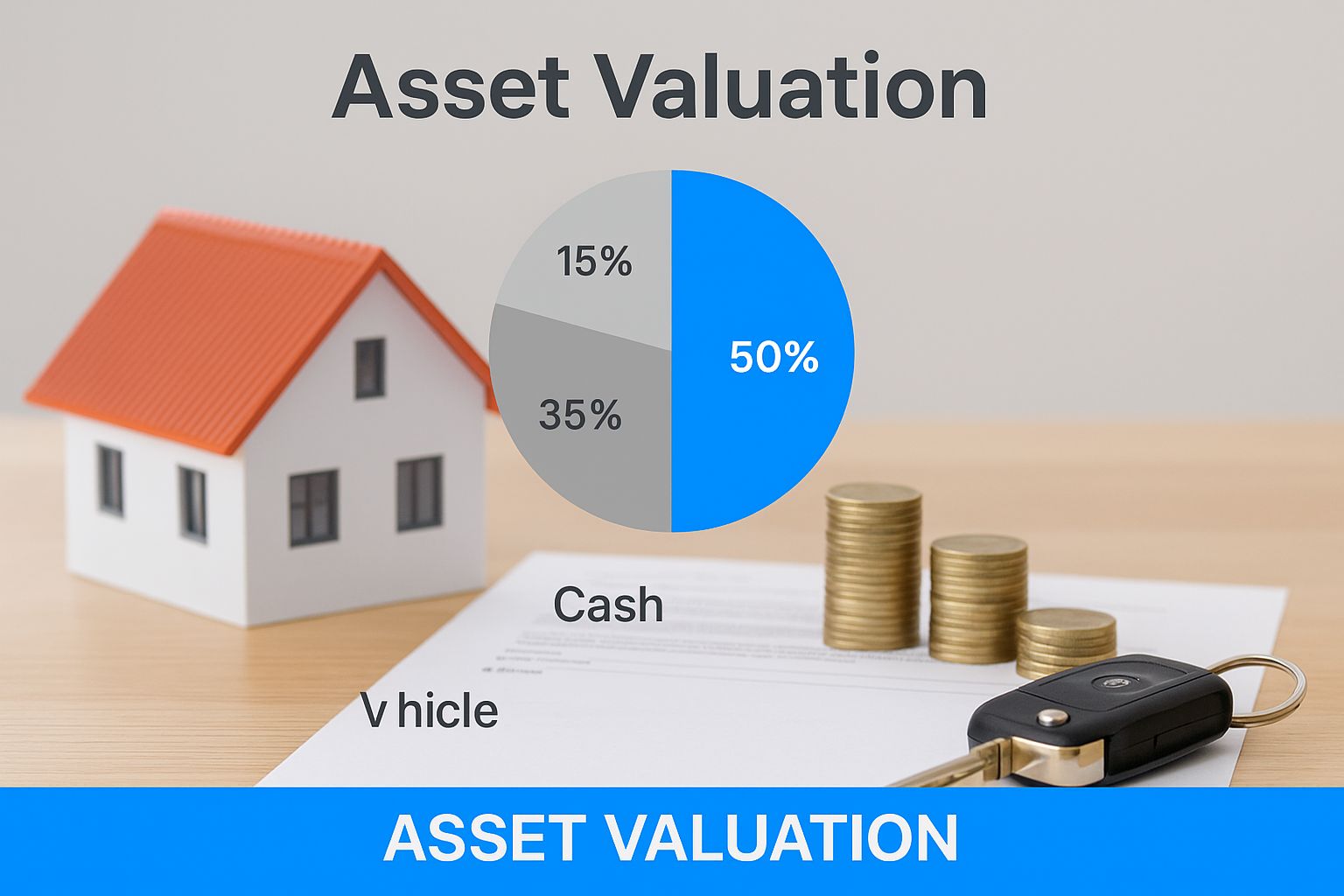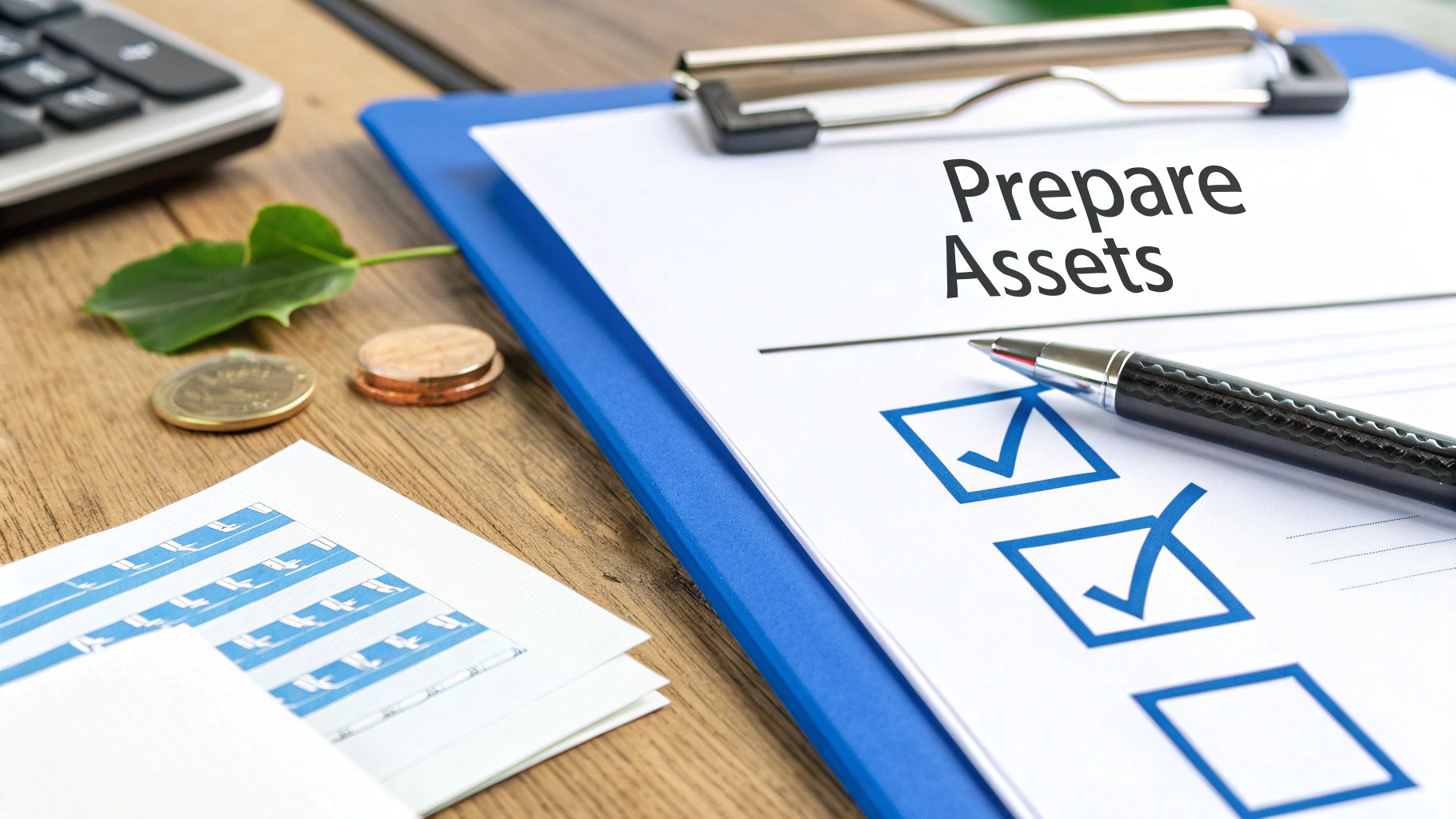How to Liquidate Assets for Maximum Return

Before you even think about pricing or marketing, there's some essential groundwork to lay. Getting this first part right is the single most important thing you can do to ensure a fast, profitable sale. It all starts with a crystal-clear picture of exactly what you have.
The Foundation: Inventory and Paperwork
Don't just jump into listing your big-ticket items. The real key to a smooth liquidation is starting with a comprehensive inventory. I'm talking about documenting everything—from heavy machinery and real estate down to the last office chair and computer monitor. A detailed spreadsheet is your best friend here.
But just making a list isn't enough. The magic happens when you start categorizing those assets. Grouping things logically is how you begin to understand their collective worth and figure out who your potential buyers are.
Smart Categorization is Everything
Think like a strategist when you organize your inventory. A simple but effective system is to group your assets by:
- Condition: Be brutally honest. Is it excellent, good, fair, or poor? Getting this right from the start prevents headaches and disputes down the line.
- Asset Type: Break it down into logical buckets like real estate, vehicles, heavy equipment, office supplies, or even intellectual property.
- Market Demand: Some things will fly off the shelves. Others need a very specific buyer. Separate your high-demand items from the specialized ones.
For example, a fleet of well-maintained delivery vans has a broad, eager market. A custom-built, one-of-a-kind manufacturing machine? That needs a much more targeted sales approach. This simple sorting exercise will shape every single decision you make from here on out.
A well-organized inventory is your roadmap for the entire liquidation. Without it, you're driving blind, almost guaranteeing you'll undervalue assets and leave money on the table.
Get Your Documents in Order
Once your inventory is dialed in, it's time to gather the paperwork. This step is completely non-negotiable for a sale to be seen as legitimate and transparent. Trust me, missing documents can stall or even kill a deal, costing you time and money.
You'll need to pull together things like ownership titles for vehicles and property, original purchase receipts, any maintenance logs you have, and existing warranties. If you're selling intangible assets like patents, make sure all the registration and transfer documents are ready to go. Having a complete file for each major asset shows you’re a serious seller and builds immediate trust with buyers.
This level of preparation is more critical than ever right now. The U.S. has been seeing some of the highest rates of corporate bankruptcies since 2010, with a staggering 371 major filings in just the first half of 2025. As explained in this report on corporate bankruptcy trends from S&P Global, this economic pressure means more assets are flooding the market. A well-documented, organized listing is how you stand out from the crowd.
Getting an Accurate Asset Valuation
Okay, you’ve got your inventory sorted. Now comes the part that trips a lot of people up: figuring out what everything is actually worth.
This is a delicate balancing act. Price your assets too high, and you'll scare away serious buyers before they even get started. But if you go too low, you’re literally leaving money on the table. A good valuation isn't just a wild guess; it’s a smart calculation that lines up with your timeline and goals.
The key is understanding that how fast you need to sell has a massive impact on the price you can expect. A rushed, "everything-must-go" sale will almost always bring in less cash than one that's been carefully planned.
What's Your Timeline Worth?
Let's break down the three main ways to look at value, because your timeline is the biggest factor here.
- Fair Market Value (FMV): This is the gold standard. It’s what an item would sell for when neither the buyer nor seller is in a hurry. You have time to find the right buyer who's willing to pay a fair price on the open market.
- Orderly Liquidation Value (OLV): Think of this as the "planned sale" price. You have a set deadline to sell everything, which puts a little pressure on. The price is usually a bit lower than FMV, but it’s far from a fire sale.
- Forced Liquidation Value (FLV): This is the "must-sell-now" scenario. It’s the rock-bottom price you’d expect in a bankruptcy or foreclosure auction where speed is everything. You're typically looking at 30-50% less than Fair Market Value.
This image really helps visualize how all the different pieces—from physical goods to real estate—come together to form the total valuation.

As you can see, it's about more than just a few big-ticket items; it’s the sum of all the parts.
To make this even clearer, let's compare these methods side-by-side so you can see where your situation fits.
Choosing the Right Valuation Method
A comparison of common asset valuation methods to help you decide which is best for your situation.
| Valuation Method | Best For | Price Expectation | Timeframe |
|---|---|---|---|
| Fair Market Value (FMV) | Patient sellers with no urgent deadline. | Highest | Flexible (Months) |
| Orderly Liquidation Value (OLV) | Planned business closures or estate sales with a clear end date. | Moderate | Defined (Weeks to a few months) |
| Forced Liquidation Value (FLV) | Urgent situations like bankruptcy or court-ordered sales. | Lowest | Immediate (Days to weeks) |
Choosing the right approach from the start sets realistic expectations and prevents a lot of frustration down the line.
Do Your Homework (And Know When to Call a Pro)
For everyday stuff like office furniture, basic equipment, or standard vehicles, a little bit of online digging will get you pretty far. The trick is to look at recently sold listings on auction sites, not just what people are asking. That real-world data tells you what buyers are actually willing to pay.
But when you're dealing with specialized or high-value assets—think industrial machinery, unique artwork, or large commercial properties—it's a smart move to bring in a professional appraiser. Their expertise gives you a defensible valuation that builds trust with buyers and ensures you’re not making a costly mistake.
This is especially true for complex situations like an estate sale, which has its own set of rules and considerations. We dive much deeper into this in our guide on what is estate liquidation, which explains how values are determined in those unique cases.
Your goal is to find that sweet spot between what an asset is theoretically worth and what someone is willing to pay for it right now. A realistic price always comes down to three things: market conditions, the asset's condition, and current buyer demand.
And this isn't a niche activity; more people and businesses are liquidating assets than ever before. The global liquidation service market was valued at $3.32 billion in 2021 and is on track to hit $4.2 billion by 2025. You can learn more about the growth of the liquidation market from Cognitive Market Research to see how these wider trends might play into your own sale.
Preparing and Marketing Your Assets for Sale
Now that you have a solid idea of what your assets are worth, it's time to make them shine. How you prepare and market your items can have a massive impact on the final sale price and how fast everything sells.
Think of it less as just "listing an item" and more like you're telling its story to attract the perfect buyer.
It’s amazing what a little effort can do. A piece of equipment that’s been wiped down and photographed in good light will always, always outperform a dusty one shot in a dark corner. This isn’t just about making things look pretty—it's about signaling value and care to your potential bidders.
The Power of Good Presentation
Before you even think about taking a single photo, let's get back to basics. A few small, inexpensive fixes can add real value, and a deep clean is completely non-negotiable.
- Clean Everything: From office chairs to heavy machinery, get rid of all the dust, grease, and grime. A clean asset instantly looks well-maintained and ready for its next owner.
- Handle Minor Repairs: Is there a wobbly leg on a table? A burnt-out indicator light on a machine? Fix it. These tiny fixes stop buyers from seeing your item as a "project" and help justify a higher price.
- Organize and Stage: Group related items and clear away any clutter around them. If you’re selling a vehicle, for example, make sure the interior is detailed and completely empty of personal junk.
A well-presented asset immediately communicates quality and reliability. In a busy market, it’s often the one thing that makes a buyer choose your item over another that’s listed for a similar price but looks neglected.
Creating Listings That Actually Sell
Your online listing is your digital storefront. High-quality photos and detailed, honest descriptions are the most powerful tools you have. This is your chance to build trust and give buyers the confidence they need to hit that "bid" button.
For photos, grab a decent camera (your phone is probably fine!) and use natural light whenever you can. Get shots from every angle, including close-ups of important features, model number plates, or even minor flaws. Transparency is your friend here; pointing out a small scratch builds way more trust than trying to hide it.
When you write the description, put yourself in the buyer's shoes. What would you need to know?
- Be Specific: Don't just say "used truck." Instead, write something like, "2018 Ford F-150 with 72,000 miles, new tires installed in March, and service records available."
- Note the Condition: Use clear terms like "Excellent," "Good," or "Fair" and then briefly explain why. For instance, "Good condition with minor cosmetic scuffs on the driver's side door."
- Set Clear Terms: Outline your payment methods, the pickup window, and any special instructions. Being clear upfront prevents headaches and disputes down the road.
We once saw a perfect example of this in action. Two companies were liquidating similar fleets of commercial vans. The first seller uploaded a few blurry, dark photos with a one-sentence description. The other took a Saturday to clean the vans, take great photos, and write detailed listings.
The second fleet ended up drawing 30% more bids and sold for a much higher average price per vehicle. The takeaway is simple: marketing effort translates directly into more money in your pocket.
Choosing the Right Sales Channel

Where you sell your stuff is every bit as important as how you price it. The sales channel you pick has a huge impact on your timeline, how much you pocket in the end, and the amount of legwork involved.
When it comes to liquidating assets, you’re generally looking at two main paths: a public auction or a private sale. Each has its own rhythm and works best in different situations.
Public auctions, especially online platforms like DIYAuctions, are all about creating a competitive buzz. Get a few buyers bidding against each other, and you can see the final price sail right past what you thought you’d get. It’s a fantastic way to generate excitement and get things sold fast, making it a go-to for common items with lots of potential buyers.
Private treaty sales, on the other hand, are a more controlled, discreet affair. You're negotiating directly with just one or a handful of serious buyers. This route can take longer, but it's often the right move for really unique or high-value assets where finding the perfect buyer is the main goal.
Auctions for Speed and Competition
When you need to move assets efficiently, the auction format is king. The built-in deadline creates a natural sense of urgency, nudging buyers to make a move.
Picture a business shutting its doors and needing to offload a dozen standard delivery vans. An auction is the perfect stage. It puts those vehicles in front of a wide audience of potential buyers all at once, and the bidding war ensures you’re getting a fair market price driven by genuine, real-time demand.
This same logic makes auctions incredibly effective for estate sales, where you’ve got a large volume of different items that need to be sold within a set timeframe. For a deeper dive into that process, check out our guide on how to run an estate sale.
An auction’s true power lies in its speed and ability to discover an item's real market value. It lets active buyers tell you what your assets are worth, which often means a higher return on popular items.
Private Sales for Control and Niche Assets
For highly specialized or incredibly expensive equipment, a private sale is almost always your best bet.
Let’s say you’re selling a custom-built CNC machine that’s worth hundreds of thousands of dollars. The list of people who can actually buy—and use—that machine is probably pretty short. A public auction might not even reach them.
In this scenario, a private sale lets you:
- Target specific buyers who you know are in the market for that exact piece of equipment.
- Negotiate the terms directly, without the pressure of a ticking clock.
- Maintain confidentiality around the final price and who bought it.
It's also worth noting the current economic climate. With insolvencies on the rise, more and more assets are hitting the market. Global bankruptcies jumped by 10% in 2024 and are expected to keep climbing. This flood of inventory means you have to be smart to make your assets stand out. Picking the right sales channel is your first, and most important, strategic decision.
Executing the Sale and Finalizing Transactions

You’ve done the hard work of preparing, valuing, and marketing your assets. Now it's time to bring it home. This final stage is all about a solid execution—because a successful sale is more than just a high bid. It’s about closing the deal securely and making sure the handover is seamless.
Whether you're in the middle of a fast-paced auction or a one-on-one negotiation, the core principles don't change. You absolutely need a clear process for handling buyers, payments, and the final transfer of ownership. I’ve seen it happen too many times: sellers rush these last steps and end up with disputes or, worse, getting scammed. Don't let that be you.
Managing Bids and Vetting Buyers
During a live auction, the bids can fly in. While a platform like DIYAuctions has built-in systems to keep things orderly, it pays to keep an eye on the action yourself. For your big-ticket items, don't hesitate to do a little homework on the winning bidder. A quick check can reveal red flags and help you sidestep potential trouble.
In a private sale, it's a more personal negotiation. Be firm on your price, but know your walk-away point and where you have some wiggle room. Once you get a serious offer, take a moment to vet the buyer. Asking for a reference or simply confirming their identity is a small, smart step that adds a crucial layer of security.
The real goal isn't just getting the highest price. It's finding a reliable buyer who is ready to complete the deal without drama. A slightly lower offer from a reputable, organized buyer is often a much better choice than a high bid from someone who seems flaky or untrustworthy.
Securing Payment and Arranging the Handover
With a committed buyer lined up, payment is the next critical hurdle. For any significant amount of money, never—and I mean never—rely on personal checks or unverified payment apps. When you're learning how to liquidate assets, making secure payment processing non-negotiable is one of the most important lessons.
These are the payment methods you should stick with:
- Credit Card Processing: Most platforms handle this for you and provide fraud protection for everyone involved. It's clean and simple.
- Wire Transfers: This is the gold standard for large sums. The funds are confirmed in your account before you release the asset. No turning back.
- Escrow Services: For truly high-value sales, an escrow service is your best friend. It holds the buyer’s money until they’ve received and approved the item, giving both of you total peace of mind.
Once the payment is confirmed and in your account, it’s time to coordinate the pickup. Be obsessively clear about the logistics—pickup times, exact locations, and who is responsible for shipping. Detailed instructions prevent no-shows and headaches, ensuring the buyer can collect their new asset smoothly.
This screenshot from the DIYAuctions platform shows exactly how we guide you through setting up these details, from the dates to the specific pickup instructions.

This structured process makes sure you don't forget any crucial details, which is key for a seamless handover.
Finally, make it all official. This means signing over titles for any vehicles or property and providing a bill of sale for all major items. This simple document is your proof of sale, officially transferring ownership and protecting you from any future claims. It’s the final handshake that closes the deal for good.
Common Liquidation Mistakes to Avoid
Knowing how to liquidate assets is one thing. But knowing which traps to sidestep is what really separates a profitable sale from a frustrating one.
I’ve seen it time and again—sellers, often in a hurry, make the same predictable mistakes that end up costing them dearly. Learning from these missteps is the easiest way to protect your final payout.
Unrealistic Pricing and Bad Timing
One of the biggest blunders is setting sky-high price expectations right out of the gate. It's so easy to get attached to what you originally paid for something or its sentimental value, but the market doesn't care about that. The market dictates an item's true worth.
Overpricing items from the start just scares away serious buyers. You end up with a stalled-out sale where you’re forced to slash prices later anyway, losing all that early momentum.
Poor timing is another killer. Trying to sell into a saturated market—like offloading a fleet of construction equipment when two other local companies just went under—is a recipe for disaster. A little bit of research into what’s happening in your local market can keep you from competing against a flood of similar items.
Lazy Marketing and Missing Paperwork
Underestimating the power of good marketing is another costly mistake. Just listing an item with a couple of blurry photos and a one-line description isn't going to get the job done.
Buyers, especially those bidding online, need to see clear, well-lit photos and read detailed descriptions to feel confident. Weak marketing leads directly to fewer bids and a lower final price. It's that simple.
The goal of liquidation isn't just to sell everything; it's to maximize your recovery value. Every mistake, from poor documentation to lazy marketing, directly chips away at the final proceeds you could have earned.
Finally, incomplete documentation can bring a promising sale to a screeching halt. A buyer for a vehicle or a piece of heavy machinery will walk away in a heartbeat if you can't produce a clean title or the maintenance records. It immediately creates suspicion and kills the deal on the spot.
By steering clear of these common errors, you’re setting yourself up for a much smoother, and more profitable, liquidation. Understanding what a well-run sale can actually achieve is a great motivator; you can get a clearer picture by exploring the data on average estate sale proceeds.
Questions We Hear All the Time
When you're looking at liquidating assets, a few questions always pop up. It's a big process, and it's smart to get the details straight before you dive in. Here are the answers to the ones we get asked most often.
How Long Does This Actually Take?
This is probably the #1 question we get, and the honest answer is: it depends. The timeline can swing wildly based on what you’re selling.
If you have straightforward items like standard office furniture or common equipment, you could wrap things up in a week. But for highly specialized industrial machinery or a piece of commercial real estate, you could be looking at a few months.
This is where the online auction format really shines. Instead of a long, drawn-out process, you can condense the entire sale into a focused timeframe, often just 7 to 14 days from start to finish.
Do I Need to Worry About Taxes?
Yes, this is definitely something to have on your radar. When you sell assets for a profit, you'll almost always have tax considerations to think about.
Any money you make from the sale could be subject to capital gains tax. The exact amount is tricky because it depends on a bunch of factors, like how long you've owned the asset and your company's or your personal income.
Our advice: Before you even think about listing that first item, have a quick chat with your accountant or a tax professional. It’s a simple step that can save you a world of headaches later on.
What’s the Difference Between a Liquidation and an Estate Sale?
It's easy to see why these two get confused, as they both involve selling off property. But there’s a key distinction.
"Liquidation" is the big-picture term. It simply means converting any kind of asset—business inventory, equipment, real estate, you name it—into cash. It’s most often used in a business context.
An "estate sale," on the other hand, is much more specific. It refers to the process of liquidating the personal property from a person's estate, usually after they have passed away.
So, you can think of an estate sale as just one specific type of asset liquidation. All estate sales are liquidations, but not all liquidations are estate sales.